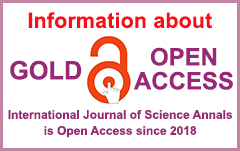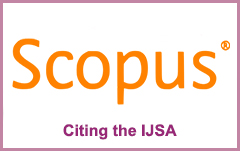| 1 H. S. Skovoroda Kharkiv National Pedagogical University, Ukraine |
Abstract
Background: This article continues a series of studies devoted to ludic competence/playfulness and one of its components is flirting.
The aim of the study: in the context of parametric concept of meaning, to identify on the basis of applied psycholinguistic research the semantic components of the stimulus “flirting person”, which are actualized in the speech acts of Russian-speaking inhabitants of Ukraine.
Material and Methods: The main method of the research is a psycholinguistic experiment whose major stage is the controlled association experiment with the stimulus “flirting person”. The sample comprised 215 young people (aged 21-35), of which 112 females and 103 males.
Results: At the final stage of formulation of the instructions 23 semantic features were selected for the stimulus “flirting person”. The results of the controlled association experiment with the stimulus “flirting person” allowed to build 23 associative fields and obtain the material for describing the behaviour pattern of ludic position Diplomat (flirting person) reflecting the reality of linguistic consciousness of young Russian-speaking inhabitants of Ukraine.
Conclusions: Cluster analysis of the associative field of the semantic feature “What is the person’s marital status?” allowed to define: three core clusters – “Free” (71.16%), “In a relationship” (14.42%), “Any” (3.72%); three peripheral clusters – “Qualities” (3.26%), “Emotional State” (3.26)%, “Role in family relations” (1.40%); extreme peripheral clusters – “Changeable” (0.93%); an isolated female reaction “Guy” suggests an ambiguous interpretation and allows to highlight different meanings – “Gender” and “Age”.
ludic competence, playfulness, ludic position, flirting person, psycholinguistic experiment, controlled association experiment, youth
Barnett, L. A. (1990). Playfulness: definition, design, and measurement. Play and Culture, 3, 319–336.
Betcher, R. W. (1981). Intimate play and marital adaptation. Psychiatry, 44(1), 13–33. https://doi.org/10.1080/00332747.1981.11024088
Bern, E. (2017). Igryi, v kotoryie igrayut lyudi: Psihologiya chelovecheskih vzaimootnosheniy. Lyudi, kotoryie igrayut v igryi: Psihologiya chelovecheskoy sudbyi [Games people play: The Psychology of human relationships. People who play games: The Psychology of human destiny]. FAIR–PRESS [in Russian].
Bowman, J. R. (1987). Making work play. In G. A. Fine (Ed.), Meaningful play, playful meanings (pp. 61–71). Human Kinetics.
Bundy, A. C. (1996). Play and playfulness: What to look for. In D. L. Parham & L. S. Fazio (Eds.), Play in occupational therapy for children (pp. 52–66). Mosby.
Chapman, J. A. (1978). Playfulness and the development of divergent thinking abilities. Child: Care, Health and Development, 4(6), 371–383. https://doi.org/10.1111/j.1365-2214.1978.tb00096.x
Chick, G., Yarnal, C., & Purrington, A. (2012). Play and mate preference: Testing the signal theory of adult playfulness. American Journal of Play, 4(4), 407–440.
Csikszentmihalyi, M. (1975). Play and intrinsic rewards. Journal of Humanistic Psychology, 15(3), 41–63. https://doi.org/10.1177/002216787501500306
Fredrickson, B. L. (2003). The value of positive emotions. American Scientist, 91(4), 330–335. https://doi.org/10.1511/2003.4.330
Givens, D. B. (1978). The nonverbal basis of attraction: Flirtation, courtship, and seduction. Interpersonal and Biological Processes, 41(4), 346–359. https://doi.org/10.1080/00332747.1978.11023994
Gordienko-Mytrofanova, I., & Kobzieva, Iu. (2018). Concept “Holy Fool” in the linguistic world-image of the Russian-speaking population of Ukraine. Psycholinguistics, 24(1), 10–24. https://doi.org/10.31470/2309-1797-2018-24-1-118-133
Gordienko-Mytrofanova, I., Kobzieva, I., & Hohol, D. (2021a). Investigating the concept of “Flirting” as reflected in the Russian-speaking Ukrainians’ linguistic consciousness. Psycholinguistics, 29(1), 8–29. https://doi.org/10.31470/2309-1797-2021-29-1-8-29
Gordienko-Mitrofanova, I. V., Sauta, S. L., Bezkorovainy, S. P., Konok, M. O., & Hohol, D. M. (2021b). “Liudyna, yaka flirtuie” v movnii svidomosti rosiiskomovnoho naselennia Ukrainy (za rezultatamy spriamovanoho asotsiatyvnoho eksperymentu) [“Flirting person” in the linguistic consciousness of the Russian-speaking population of Ukraine (based on the results of the controlled associative experiment)] [Manuscript submitted for publication]. International Journal of Education and Science, 4(2). [in Ukrainian]
Groos, K. (1976). The play of man: Teasing and love-play. In J. Brunner, A. Jolly, & K. Sylva (Eds.), Play, development and evolution (pp. 62–83). Penguin Books.
Guitard, P., Ferland, F., & Dutil, É. (2005). Toward a better understanding of playfulness in adults. OTJR: Occupation, Participation and Health, 25(1), 9–22. https://doi.org/10.1177/153944920502500103
Hall, J. A. (2013). The five flirting styles: Use the science of flirting to attract the love you really want. Harlequin.
Hall, J., Carter, S., Cody, M. J., & Albright, J. M. (2010). Individual differences in the communication of romantic interest: Development of the flirting styles inventory. Communication Quarterly, 5(4), 365–393. https://doi.org/10.1080/01463373.2010.524874
Henningsen, D. D., Braz, M., & Davies, E. (2008). Why do we flirt? Flirting motivations and sex differences in working and social contexts. The Journal of Business Communication, 45(4), 483–502. https://doi.org/10.1177/0021943608319390
Karaulov, Yu. N., Cherkasova, G. A., Ufimtseva, N. V., Sorokin, Yu. A., & Tarasov, Ye. F. (2002). Russkiy assotsiativnyy slovar [Russian associative dictionary]. Astrel. [in Russian]
Kobzieva, Iu., Gordiienko-Mytrofanova, I., Udovenko, M., & Sauta, S. (2020). Concept “Humour” in the linguistic consciousness of the Russian-speaking population of Ukraine. European Journal of Humour Research, 8(1), 29-44. https://doi.org/10.7592/EJHR2020.8.1.kobzieva
Kobzieva, I., Gordiienko-Mytrofanova, I., Zuiev, I., & Sauta, S. (2019). Razrabotka oprosnika igrovoy kompetentnosti (OIK) [Development of ludic competence questionnaire (LCQ)]. Psychological Journal, 5(12), 280–301. https://doi.org/10.31108/1.2019.5.12.19 [in Russian]
Kobzieva, Yu. A. (2020). Psykholohichni ta psykholinhvistychni osoblyvosti rozvytku humoru yak komponenta ihrovoi kompetentnosti [Psychological and psycholinguistic features of the development of humor as a component of ludic competence] [Doctoral dissertation]. Hryhorii Skovoroda University in Pereiaslav. https://ephsheir.phdpu.edu.ua/handle/8989898989/5243?show=full [in Ukrainian]
Lauer, J. C., & Lauer, R. H. (2002). The play solution: How to put the fun and excitement back into your relationship. McGraw-Hill.
Proyer, R. T. (2017). A new structural model for the study of adult playfulness: Assessment and exploration of an understudied individual differences variable. Personality and Individual Differences, 108, 113–122. https://doi.org/10.1016/j.paid.2016.12.011
Proyer, R. T. (2012). Examining playfulness in adults: Testing it’s correlates with personality, positive psychological functioning, goal aspirations, and multi-methodically assessed ingenuity. Psychological Test and Assessment Modeling, 54(2), 103–127.
Proyer, R. T., & Jehle, N. (2013). The basic components of adult playfulness and their relation with personality: The hierarchical factor structure of seventeen instruments. Personality and Individual Differences, 55(7), 811–816. https://doi.org/10.1016/j.paid.2013.07.010
Proyer, R. T., & Wagner, L. (2015). Playfulness in adults revisited: The signal theory in German speakers. American Journal of Play, 7(2), 201–227.
Qian, X. L., & Yarnal, C. (2011). The role of playfulness in the leisure stress-coping process among emerging adults: an SEM analysis. Leisure/Loisir, 35(2), 191–209. https://doi.org/10.1080/14927713.2011.578398
Raven, J. (2001). The conceptualisation of competence. Peter Lang Publishing, Inc.
Rodgers, J. E. (1999, January 1). Flirting fascination. Psychology Today. https://www.psychologytoday.com/intl/articles/199901/flirting-fascination
Schaefer, C., & Greenberg, R. (1997). Measurement of playfulness: A neglected therapist variable. International Journal of Play Therapy, 6(2), 21–31. https://doi.org/10.1037/h0089406
Shen, X. (2010). Adult playfulness as a personality trait: Its conceptualization, measurement, and relationship to psychological well-being [Doctoral dissertation]. The Pennsylvania State University. https://etda.libraries.psu.edu/catalog/11579
Sternin, I. A. (1985). Leksicheskoye znacheniye slova v rechi [The lexical meaning of word in speech]. Lambert. [in Russian]
Sternin, I. A. (2011). Psiholingvisticheskoe znachenie slova i ego opisanie [Psycholinguistic meaning of the word and its description]. Lambert. [in Russian]
Watzlawick, P. (1993). The situation is hopeless, but not serious (The pursuit of unhappiness). Revised ed. W. W. Norton & Company. https://doi.org/10.1111/j.1545-5300.1984.121_8.x
Weber, M., & Ruch, W. (2012). The role of character strengths in adolescent romantic relationships: An initial study on partner selection and mates’ life satisfaction. Journal of Adolescence, 35, 1537–1546. https://doi.org/10.1016/j.adolescence.2012.06.002
Whitty, M. Th. (2003). Cyber-flirting: playing at love on the Internet. Theory & Psychology, 13(3), 339–357. https://doi.org/10.1177/0959354303013003003
Woll, S. B. (1989). Personality and relationship correlates of loving styles. Journal of Research in Personality, 23(4), 480–505. https://doi.org/10.1016/0092-6566(89)90016-0
Yue, X. D., Leung, C. L., & Hiranandani, N. A. (2016). Adult playfulness, humor styles, and subjective happiness. Psychological Reports, 119(3), 630–640. https://doi.org/10.1177/0033294116662842
Gordienko-Mytrofanova Iya Vladimirovna – https://orcid.org/0000-0001-5332-0663; Doctor of Psychological Sciences, Professor, Department of Psychology, H. S. Skovoroda Kharkiv National Pedagogical University, Kharkiv, Ukraine.
Hohol Denis Mykhailovich (Corresponding Author) – https://orcid.org/0000-0002-4594-0720;
Nesterenko Margarita Alekseevna – https://orcid.org/0000-0002-8772-134X; Doctor of Philosophy in Psychology, Associate Professor, Department of Psychology, H. S. Skovoroda Kharkiv National Pedagogical University, Kharkiv, Ukraine.
| |
APA
Gordienko-Mytrofanova, I. V., Hohol, D. M., & Nesterenko, M. A. (2021). Developing the instructions for the controlled association experiment by means of semantic features for the stimulus “flirting person”. International Journal of Science Annals, 4(1), 22–32. https://doi.org/10.26697/ijsa.2021.1.4
Harvard
Gordienko-Mytrofanova, I. V., Hohol, D. M., & Nesterenko, M. A., 2021. "Developing the instructions for the controlled association experiment by means of semantic features for the stimulus “flirting person”". International Journal of Science Annals, [online] 4(1), pp. 22–32. viewed 30 June 2021, https://culturehealth.org/ijsa_archive/ijsa.2021.1.4.pdfVancouver
Gordienko-Mytrofanova I. V., Hohol D. M., Nesterenko M. A. Developing the instructions for the controlled association experiment by means of semantic features for the stimulus “flirting person”. International Journal of Science Annals [Internet]. 2021 [cited 30 June 2021]; 4(1): 22–32. Available from: https://culturehealth.org/ijsa_archive/ijsa.2021.1.4.pdf https://doi.org/10.26697/ijsa.2021.1.4












